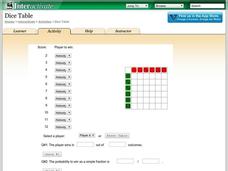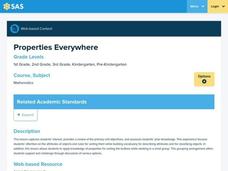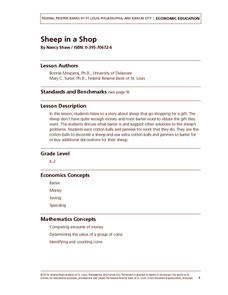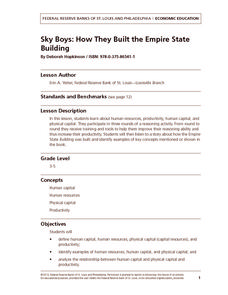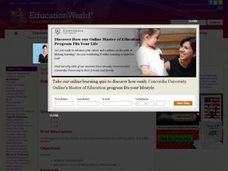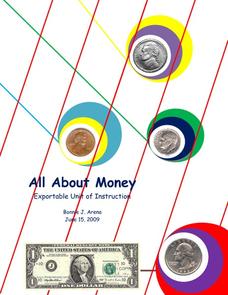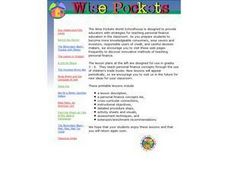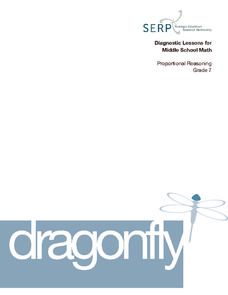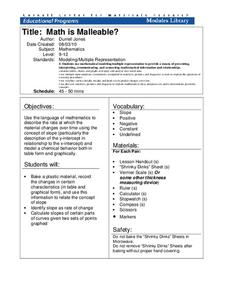Shodor Education Foundation
Dice Table
Convert a table to probabilities. Pupils set up the winning rules for the sums of two dice. Using the rules, the applet fills out a table showing the winners for each combination. Learners determine the probabilities of winning for each...
Shodor Education Foundation
Overlapping Gaussians
Adjust the overlap to compare probabilities. Using sliders, learners adjust the shape of two Gaussian curves. The interactive calculates the area of the left tail for one curve and the right tail for the other. Pupils set the interactive...
Pennsylvania Department of Education
Properties Everywhere
Pupils examine and sort objects by specific attributes and apply prior knowledge. In this properties everywhere lesson, students work in groups to arrange objects in categories then discuss various sorting options while using descriptive...
Curated OER
Bingo Brown and the Language of Love
Students study credit and interest in a novel and consumer math activity. In this credit lesson, students read the book Bingo Brown and the Language of Love. Students discuss the book and the ideas of credit, interest, and loans....
Federal Reserve Bank
Sheep in a Shop
What do you think sheep might be able to barter when they don't have quite enough to buy a gift? Your pupils can find out this and much more during this lesson about Sheep in a Shop, spending, saving, and bartering.
Curated OER
The Is No Such Thing as a Perfect Pumpkin
Students explore using descriptive words to describe physical appearance. In this appearance instructional activity, students look at pumpkins and discuss how there is not a perfect pumpkin. Students also hypothesize about what the...
Federal Reserve Bank
Sky Boys: How They Built the Empire State Building
How tall is the Empire State Building? Lead your class through a collaborative estimation activity to determine the number of quarters it would take to reach the top and teach the following concepts: human capital, human resources,...
Curated OER
What Language Do You Speak?
Fourth graders engage in a lesson based on a game and is to be played in groups. A card be drawn from a deck. On this card is a verbal description of a mathematical statement. They use worksheets imbedded in this lesson which give...
Curated OER
Oral Language in Mathematics
Third graders examine fractions by descriptively writing about them. For this number sense lesson, 3rd graders read number sentences and compare fractions based on their size. Students explain fractions to a friend by writing a friendly...
Curated OER
Adjective Monster
Explore descriptive writing and visual art. Listen to the story Go Away Big, Green Monster by Ed Emberley and generate a list of adjectives used in the book. Name familiar shapes and create a shapes list. Choose an adjective and shape to...
Curated OER
Hello My Name is . . . Helvetica
Students play various games to help create a classroom community. In this name recognition lesson, students combine their name recognition skills with newly learned art and geometric vocabulary. First students discover vocabulary that...
Curated OER
Egg Hunt Reinforces Math, Language Skills
It's amazing what you can do to reinforce math skills while leading an egg hunt! Learners of all ages will benefit from playing this simple game.
Curated OER
Lemonade For Sale
2-3rd graders listen to the story, Lemonade for Sale, by Stuart J. Murphy. In the story, children produce and sell lemonade to raise money for their clubhouse, create a product, classify the resources used in production as natural...
Ahisma Summer Institute
The Power of One - Math in a Different Angle
In this 2-day lesson focused on exponents, middle schoolers will cross the curriculum by engaging in science, history and language arts activities. Exponential growth will be explored using grains of rice on a chess board. Exponential...
Curated OER
All About Money
Few topics engage young mathematicians as much as learning about money. Through a series of shared readings and hands-on activities, children explore the US currency system, learning how to count money and calculate change as they create...
Federal Reserve Bank
“W” Is for Wages, W-4 and W-2
Don't let your young adults get lost in the alphabet soup of their paychecks and federal income taxes. Using sample pay stubs and reproductions of government forms, your class members will identify the purpose of such forms as a W-4 and...
Curated OER
Wise Pockets
Using children's picture books and role-playing activities, youngsters begin to learn about personal finance management. These lesson plans are engaging and intend to endow pupils with skills for making wise decisions with money as they...
Curated OER
What's My Structure
Fourth graders use the language of mathematics to describe in words a 3-D structure created with one-inch cube. They interpret a written description of a 3-D structure and re-create it with one-inch cubes. Students use Quick Time...
Curated OER
Taller/Wider/longer
In this unit, 1st graders use measurement language and counting to compare objects in a variety of game situations. Students also practice the advanced concept of counting to advanced counting.
Curated OER
Dragonfly
The speed of a dragonfly brings math into the real world as your learners collaboratively see the value in calculating unit rates in direct proportion problems. This six-phase lesson encourages you, as the teacher, to only ask questions...
EngageNY
Ratios II
Pupils continue the study of ratios by creating ratios from a context. The contexts present more than two quantities, and scholars create contexts that match given ratios.
Federal Reserve Bank
Less Than Zero
Perry the penguin wants to buy a new scooter, but he doesn't have any funds! Walk your kids through the short book Less Than Zero, and have them track his borrowing, spending, and saving on a line graph while you read. Pupils will learn...
CK-12 Foundation
Whole Number Addition: Let's Go Fishing!
Practice adding whole numbers by combining the amount of fish Alice and Bob catch. As young mathematicians work through each problem, they are asked to find one more plus the amount of fish already caught. They can manipulate the...
Cornell University
Math Is Malleable?
Learn about polymers while playing with shrinky dinks. Young scholars create a shrinky dink design, bake it, and then record the area, volume, and thickness over time. They model the data using a graph and highlight the key features of...


